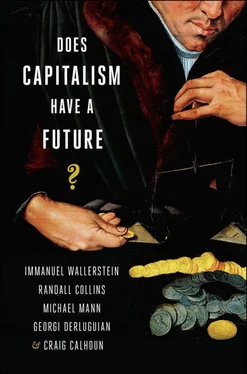The next set of debtors was the wave of large corporations which, beginning in the 1980s, issued the famous junk bonds as a means of overcoming their liquidity problems. This led to acquisitions by a group of ravenous investors, who made their money by stripping the enterprises of material value. The 1990s saw the beginning of extensive individual indebtedness, especially in the North, made possible by extensive use of credit cards and then later investment in housing. The first decade of the 21st century saw the remarkable rise in public indebtedness of the United States resulting from the combination of enormous war costs and large-scale reduction in tax income. With the collapse of the US housing market in 2007, the world’s press and politicians took public note of a “crisis,” the efforts to “bail out” the banks and, in the case of the United States, to print currency. This was followed by the ever-widening circle of indebtednesses of governments, leading to pressures everywhere for austerity measures to reduce state debt, which reductions simultaneously have reduced effective demand.
The first decade of the 21st century has also seen the geographic relocation of capital appropriation. The rise of the so-called emergent countries, notably the BRICS (Brazil, Russia, India, China, and South Africa), is the kind of slow reordering of the hierarchy of the modern world-system that has been seen regularly before. However, this presumes that there is room in the system for new productive leading industries, something the generalized profit squeeze seems to counterindicate. Rather, the rise of the BRICS has involved a widening of the numbers of persons involved in partaking of the distribution of world surplus value. This actually reduces, not increases, the possibilities of the endless accumulation of capital, and intensifies rather than counteracts the structural crisis of the world-system. Furthermore, the austerity measures now so widespread are reducing the customer base for the exports of the BRICS.
The most likely financial result of the economic turmoil will be the final eviction of the United States dollar as the world’s reserve currency, followed not by another currency performing this function, but a multicurrency world that allows for the constant fluctuations of exchange rates, a further inducement to the freezing of the financing of new productive activity.
Meanwhile, and simultaneously, the decline of US hegemony became irreparable after the blowback caused by the political-military fiasco of the neocon program of unilateral military machismo undertaken in the period 2001–2006 by the administration of President George W. Bush. The outcome has been the reality of a multipolar world, in which there are eight to ten centers of power, sufficiently strong that they can negotiate with other centers with relative autonomy. However, there are now too many centers of power. One consequence is the frequent tentative geopolitical realignments, as each of these centers seeks maximum advantage. Fluctuating markets and currencies are thereby reinforced by fluctuating power alliances.
The basic reality is unpredictability not merely in some middle run but very much in the short run. The sociopsychological consequences of this short-run unpredictability have been confusion, anger, disparagement of those in power, and above all acute fear. This fear leads to the search for political alternatives of kinds not entertained before. The media refer to this as populism, but it is far more complicated than this slogan term suggests. For some the fear leads to multiple and irrational scapegoatings. For others, it leads to the willingness to unthink deeply ingrained assumptions about the operations of the modern world-system. This can be seen in the United States as the difference between the Tea Party movement and the Occupy Wall Street movement.
The main concern of every government in the world—from the United States to China, from France to Russia to Brazil, not to speak of all the weaker governments on the world scene—has become the urgency of averting an uprising of unemployed workers joined by middle strata whose savings and pensions are disappearing. One reaction has been that the governments have all become protectionist (while vigorously denying this). The reason for this protectionist thrust is that governments are seeking to obtain short-term money, however they can and at whatever price they have to pay. Since protectionism is insufficient to overcome unemployment, governments are also becoming more repressive.
This combination of austerity, repression, and the search for short-term money makes the global situation even worse. It accounts for an ever-tighter gridlock of the system. Gridlock in turn will result in ever-wilder fluctuations, and will consequently make short-term predictions—both economic and political—ever more unreliable. And this in turn will aggravate the popular fears and alienation. It is a negative cycle.
The Political Struggle over the Replacement System
The question before the world today is not in what way governments can reform the capitalist system such that it can renew its ability to pursue effectively the endless accumulation of capital. There is no way to do this. The question therefore has become what will replace this system. And this is a question both for the 1% and the 99%, in the language used since 2011. Of course, not everyone agrees, or phrases it this way. Indeed, most people still assume that the system is continuing, using the old rules, perhaps after amending the rules. This is not wrong. It is just that, in the present situations, using the old rules actually intensifies the structural crisis.
There are however some actors who are quite aware of the structural crisis. They are aware that while we cannot maintain the present system, we can contribute to deciding which prong of the bifurcation the world will take, what kind of new historical system the world will construct. Whether we acknowledge it or not, we are living amidst a struggle for the successor system. While complexity studies insists that the outcome of such a bifurcation is intrinsically unpredictable, nonetheless the options between which the world will choose are quite straightforward, and can be sketched in broad terms.
One kind of possible new stable system is one that retains the basic features of the present system: hierarchy, exploitation, and polarization. Capitalism is far from the only kind of system that can have such features, and the new one could be far worse than capitalism. The logical alternative to this is a system that is relatively democratic and relatively egalitarian. This latter has never yet existed; it is only a possibility. Of course, none of us can design either alternative in institutional detail. Such a design will evolve as the new system begins its life.
I have given symbolic names to the two possibilities. I call them “the spirit of Davos” and “the spirit of Porto Alegre.” The names themselves are unimportant. What we need to analyze are the probable organizational strategies on each side in this struggle that started more or less in the 1970s and will continue in all probability to circa 2040 or 2050.
The political struggles of a structural crisis have two basic characteristics. First, there is a fundamental change of the situation from that of the “normal” operation of an historical system. During “normal” life, there exists a very strong pressure to return to equilibrium. That is what makes it “normal.” But in a structural crisis, the fluctuations are wide and constant, and the system is ever further from equilibrium. This is the definition of a structural crisis. It follows that however radical are “revolutions,” during “normal” times their effect is limited. In contrast, during a structural crisis, small social mobilizations have very great effects. This is the so-called butterfly effect, when free will prevails over determinism.
Читать дальше












